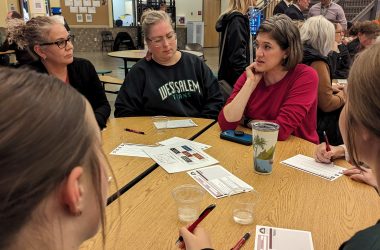 Hallman students gather during the school’s morning assembly. (Fred Joe/Special to Salem Reporter)
Hallman students gather during the school’s morning assembly. (Fred Joe/Special to Salem Reporter)
As the Salem-Keizer School District weighs how to spend millions of dollars in new state money, teachers are pushing to shrink class sizes.
That’s put teachers at odds with a volunteer task force that will soon recommend how that money should be spent.
The task force is led by Reginald Richardson, vice president of the Salem-Keizer NAACP, and Adriana Miranda, executive director of Causa and a Salem-Keizer parent. Many district employees are part of the group.
Their task is to recommend ways to boost the school performance for groups of students who lag behind their peers: black, Pacific Islander and Native American students, students from low-income families, with disabilities, learning English or who are homeless or in foster care.
About eight in 10 Salem-Keizer students belong to one of those groups.
A consensus is emerging among task force members for steps the district should take. They include more extracurricular activities with free transportation and low or no fees and hiring more social workers and counselors for student mental health. They also include better training for employees who work with challenged students and hiring a more diverse and bilingual staff.
DOCUMENT: Salem-Keizer task force priorities list
Educators see class size as a factor for nearly every challenge in local schools, from student mental health to better serving English learners. Many teachers, from Salem-Keizer and around Oregon, cited class size in signs and speeches when marching at the Capitol in support of the extra funding last spring.
“With lower class sizes that’s where we have the ability to have those relationships with our students,” said Mindy Merritt, president of the Salem-Keizer Education Association, who serves on the task force.
She said many issues apparent in the data the task force has reviewed, including students reporting a low sense of belonging at school, would improve with more time with teachers.
But Richardson and Miranda said the task force is guided by what volunteers heard from the whole community, not only educators. And the assignment was to focus resources on narrowing gaps for particular groups of students, not general educational improvements.
“We’re supposed to be applying an equity lens to this,” Richardson said.
That means paying more attention to feedback from the groups state officials said schools are supposed to help.
A survey of 2,100 district employees ranked smaller class size as their highest priority for the money. About half of those surveyed were teachers; most of the rest are classroom aides and other non-administrative staff.
Many schools separately listed cutting student counts in class as a top priority in feedback sent to the task force.
Parents, students and others who have weighed in don’t share that urgency. Those participating in a community survey ranked more instructional time highest with class size ranking near the bottom.
Merritt suggested part of that gap may be because parents and students don’t understand how large some classes are across the district.
Salem-Keizer’s median class size last school year was 27, according to the Oregon Department of Education. No elementary school classroom had more than 35 students, but hundreds of high school classes did, including core courses like math and English.
The data is based on a one-day sample of enrollment on May 1, so may not reflect a class over the course of the year.
Lower teacher-to-student ratios will almost certainly be part of the district’s plan, said assistant superintendents Kraig Sproles and Linda Myers, who have been working with the community volunteers leading the task force.
But those reductions will be targeted to groups like students learning English or those with disabilities, rather than a districtwide drop in class size at every school, Sproles said.
Reducing class size was among the task force’s “strategic priorities,” meaning it was rated highly by about half of the groups of volunteers.
How significant those reductions should be, and how they should be balanced by other priorities has been a contentious point in recent meetings, with Merritt pushing for educators’ top priority to receive more consideration.
“My members are demanding class size,” she said at the Jan. 23 meeting, citing the survey data.
“Your members are a voice, but they’re not the only voice we incorporate into our process,” Sproles responded. “We want to respect that voice” without weighing it above others, he said.
In a Jan. 23 email before the meeting, Merritt laid out one plan that would spend $21.5 million – about 60% of the new money – on hiring classroom staff across all grades to reduce class size.
Research on the effectiveness of reducing class size to boost student achievement is mixed. An often-cited study in Tennessee in the 1980s found large reductions in class size in early elementary school boosted academic gains. But those reductions were significant, about seven fewer students per class, which would be costly to implement.
In education, where funding is always more scarce than educators would like, the question isn’t only whether smaller class size helps students. It’s also about whether it’s the most cost-effective way to improve schooling.
Richardson said he’s not convinced.
Class size came up in many meetings with parents and students, he said, but other issues were a higher priority, like staff diversity and better access to school programs outside of class.
Educators’ voices matter but “can’t outweigh people we know who attended very specific conversation groups,” he said.
Merritt said she can’t say whether the task force’s recommendations are adequate since they haven’t been finalized. She said she’s pushing class size in meetings because the issue felt like an “elephant in the room” that wasn’t being addressed openly.
The task force is scheduled for a final meeting Thursday, Jan. 30, and leaders will present its recommendations at a Feb. 11 school board meeting.
Reporter Rachel Alexander: [email protected] or 503-575-1241.

Rachel Alexander is Salem Reporter’s managing editor. She joined Salem Reporter when it was founded in 2018 and covers city news, education, nonprofits and a little bit of everything else. She’s been a journalist in Oregon and Washington for a decade. Outside of work, she’s a skater and board member with Salem’s Cherry City Roller Derby and can often be found with her nose buried in a book.









